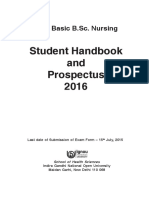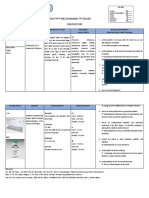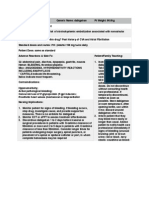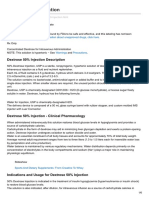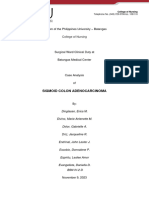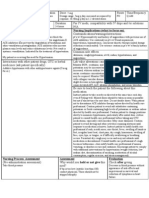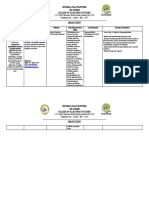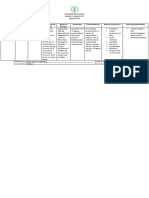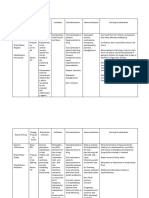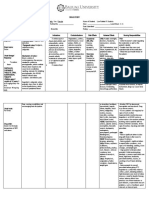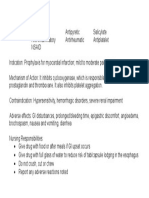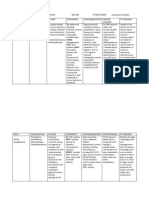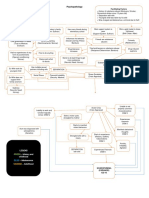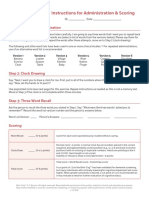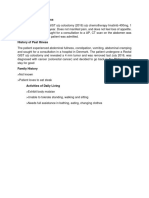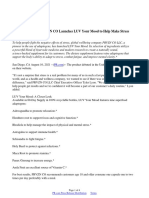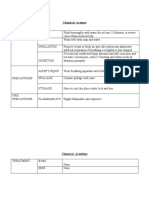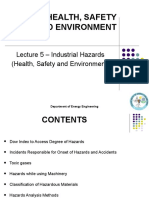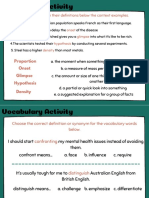Drug Study
Drug Study
Uploaded by
Abigail LonoganCopyright:
Available Formats
Drug Study
Drug Study
Uploaded by
Abigail LonoganOriginal Description:
Copyright
Available Formats
Share this document
Did you find this document useful?
Is this content inappropriate?
Copyright:
Available Formats
Drug Study
Drug Study
Uploaded by
Abigail LonoganCopyright:
Available Formats
Generic Name: Celecoxib
Brand Name:
Dosage: 200mg 1 cap BID
Classification: Nonsteroidal Anti-Inflammatory Drugs
Indication: Treatment of osteoarthritis, pain, rheumatoid arthritis, juvenile idiopathic arthritis, ankylosing
spondylitis. Reduction of the number of colorectal polyps.
Contraindication: Allergies to sulphonamides, celecoxib, NSAIDs, or aspirin; significant renal
impairment. Hypersensitivity to celecoxib and sulfonamides.
Mode of Action: Celecoxib is a selective cyclooxygenase-2 (COX-2) inhibitor primarily responsible to
reduce mediators of pain and inflammation. Its action is due to inhibition of
prostaglandin synthesis via inhibition of COX-2.
Adverse Effects: Sinusitis, upper resp tract infection, UTI, allergy aggravated, insomnia, dizziness,
hypertonia, MI, pharyngitis, rhinitis, cough, dyspnoea, vomiting, diarrhoea, dyspepsia,
abdominal pain, flatulence, dysphagia, rash, pruritus, flu-like symptoms, peripheral
oedema/fluid retention, jaundice, liver necrosis
Nursing Responsibility: May be taken with or without meals. Advise patient to report signs or symptoms
of GI toxicity (abdominal pain, black stools) or hepatotoxicity (nausea, fatigue,
flu-like symptoms)
Generic Name: Calcium + Vitamin D
Brand Name:
Dosage: 1 tab OD
Classification: Calcium with Vitamins / Antacids, Antireflux Agents & Antiulcerants / Electrolytes
Indication: Hyperphosphataemia in patients with chronic renal failure. Hyperacidity
Contraindication: Patients with Ca renal calculi or history of renal calculi; hypercalcaemia;
hypophosphataemia. Patients with suspected digoxin toxicity.
Mode of Action: Calcium carbonate can neutralise gastric acid rapidly and effectively. However, it
may adversely activate Ca dependent processes, leading to secretion of gastric and
hydrochloric acid. It can induce rebound acid secretion and, prolonged high doses
may cause hypercalcemia, alkalosis and milk-alkali syndrome.
Side Effects: Constipation, flatulence; hypercalcaemia; metabolic alkalosis; milk-alkali syndrome, tissue-
calcification. Gastric hypersecretion and acid rebound (with prolonged use).
Nursing Responsibility: Monitor VS especially BP and PR. Obtain ECG result. Asses for heartburn,
indigestion, abdominal pain. Monitor serum calcium before treatment. Assess for
nausea and vomiting, anorexia, thirst, severe constipation
Generic Name: Benzydamine Hydrochloride
Brand Name:
Dosage: 2 sprays TID
Classification: NSAID with analgesic, anti-pyretic and anti-inflammatory
Indication: Treatment of pain minor infection and inflammation common to uncomplicated sore
throat, oral surgery, minor mouth infections and dental procedures.
Contraindication: Known sensitivity to any of the active ingredients or the excipients. Known sensitivity
to other local anaesthetic agents. This product is contraindicated in
phenylketonurics, since it contains aspartame, which is metabolised in the GIT to
phenylalanine.
Mode of Action: Benzydamine hydrochloride is a non-steroid anti-inflammatory drug that has
analgesic, antipyretic and anti-inflammatory actions. It is used for the relief of
inflammatory conditions of the mouth and throat
Side Effects: Sensitisation can occur to anaesthetics due to prolonged use, over use or inappropriate
use. The most common side effects when large quantities of isomalt are ingested are
gastrointestinal disturbance. Excess consumption of the lozenges will result in excessive
isomalt intake and can cause laxative effects.
Generic Name: Co-Amoxiclav
Brand Name:
Dosage: 1 gm IV BID
Classification: Antibacterial
Indication: Known or suspected amoxicillin-resistant infections including respiratory tract, skin and soft
tissue, genitourinary, and ear, nose and throat infections. Effective against strains of
Escherichia coli, Proteus mirabilis, Haemophilus influenza, Streptococcus faecalis,
Streptococcus pneumoniae and some beta- lactamase-producing organisms
Contraindication: History of penicillin hypersensitivity. Superinfections involving Pseudomonas or
candida
Mode of Action: Co-amoxiclav is an antibacterial combination consisting of amoxicillin (as sodium)
and the beta-lactamase inhibitor, clavulanic acid (as potassium clavulanate).
Amoxicillin is the 4- hydroxy analogue of ampicillin. Amoxicill in hinders the cell wall
synthesis of sensitive bacteria and is bactericidal against many Gram-positive and
Gram-negative bacteria
Side Effects: Lethargy, hallucinations, seizures, glossitis, sore mouth, furry tongue, black “hairy tongue”,
nausea and vomiting, diarrhea, abdominal pain, bloody diarrhea, enterocolitis
Nursing Responsibility: Assess bowel pattern before and during treatment as pseudo membranous
colitis may occur. Report hematuria or oliguria as high doses can be
nephrotoxic. Assess respiratory status. Observe for anaphylaxis. Ensure that the
patient has adequate fluid intake during any diarrhea attack
Generic Name: Difflam Throat Spray
Brand Name:
Dosage: 2 sprays TID
Classification: Non- steroidal anti- inflammatory drug; analgesic
Indication: Relief of painful conditions of the oral cavity including tonsillitis, sore throat, radiation
mucositis, aphthous ulcers, post-orosurgical & periodontal procedures, pharyngitis, swelling
& inflammatory conditions. Antiseptic.
Contraindication: There are no known contraindications except for hypersensitivity
Mode of Action: It selectively binds to inflamed tissues (Prostaglandin synthetase inhibitor) and is
normally free of adverse systemic effects. Unlike other NSAIDs, it does not inhibit
cyclooxygenase or lipooxygenase, and is not ulcerogenic
Side Effects: Oral numbness; dryness or thirst, tingling, warm feeling in mouth, altered sense of taste.
Nursing Responsibility: Spray directly onto the sore/inflammed area & swallow gently.
Generic Name: Hexetidine Gargle
Brand Name:
Dosage: 10mL TID after meals
Classification: Oral antiseptic
Indication: Minor sore throat; halitosis, general oral hygiene. Improves appearance of mouth tissue,
protects tooth surfaces afaints formation of decay acids.
Contraindication: Lesions and ulcerations of oral/buccal mucosa
Mode of Action: Protection against oral bacterial and fungal infection to give fast relief from sore
throat and mouth ulcers. First, bactidol quicly reduces bacteria in the affected areas
to help relieve and prevent soreness, then hexetidine contains adheres to affected
areas for extended period of time, giving long lasting protection.
Side Effects: Taste disturbances, transient anaesthesia, irritation, sensitization
Nursing Responsibility: Assess for lesions. Instruct patient to swallow the medication
Generic Name: Cefuroxime
Brand Name:
Dosage:
Classification: Cephalosporins
Indications: Susceptible infections. Uncomplicated UTI. Respiratory tract infections. Lyme disease.
Uncomplicated gonorrhoea. Susceptible infections. Pneumonia. Acute exacerbations of
chronic bronchitis. Prophylaxis of surgical infections. Meningitis. Gonorrhoea
Contraindication: Hypersensitivity to cefuroxime or to other cephalosporins.
Mode of Action: Cefuroxime inhibits bacterial cell wall synthesis by binding to one 1 or more of the
penicillin-binding proteins (PBPs) which in turn inhibit the final transpeptidation step of
peptidoglycan synthesis in bacterial cell walls, thus inhibiting cell wall biosynthesis and
arresting cell wall assembly resulting in bacterial cell death.
Side Effects: Body as a Whole: Thrombophlebitis (IV site); pain,burning, cellulitis (IM site); superinfections,
positive Coombs'test. GI: Diarrhea, nausea, antibiotic-associated colitis. Skin: Rash,
pruritus, urticaria. Urogenital: Increased serum cretonne and BUN, decreased creatinine
clearance
Nursing Responsibility: Determine history of hypersensitivity reactions to cephalosphorins, penicillins and
history of allergies particularly to drugs before therapy is initiated. Instruct to
report onselt of loose stools. Absorption of cefuroxime is enhanced by food.
Notify prescriber about rashes or superinfections.
Generic Name: Ketomed
Brand Name:
Dosage:
Classification: Non-steroidal Anti-inflammatory Drugs (NSAID)
Indication: Short-term management of moderate to severe acute post-op pain.
Contraindication: Hypersensitivity to ketorolac tromethamine, other NSAIDs, aspirin or other
prostaglandin synthesis inhibitors induce allergic reactions (severe anaphylactic-like
reactions). History of asthma. History of or active peptic ulceration or GI bleeding;
suspected or confirmed cerebrovascular bleeding, hemorrhage diatheses including
coagulation disorders; complete or partial syndrome of nasal polyps, angioedema or
bronchospasm. Moderate or severe renal impairment (serum creatinine >160
mmol/L). Pregnancy (labor & delivery) & lactation. Inj: Hypovolemia (any cause or
dehydration). Patients who undergone operations w/ a high risk of hemorrhage or
incomplete hemostasis.
Mode of Action: Reversibly inhibits cyclooxygenase -1 and -2 (COX-1 and -2) enzymes, which result in
decreased formation of prostaglandin precursors. It exhibits minimal anti-inflammatory
effect at its analgesic dose.
Side Effects: Nausea, dyspepsia, GI pain & bleeding; abdominal discomfort, hematemesis, gastritis,
esophagitis, diarrhea, eructation, constipation, flatulence, fullness, melena, peptic ulcer,
nonpeptic GI ulceration, rectal bleeding, ulcerative stomatitis.
Nursing Responsibility: Monitor BP upon administration. < 90/80 never administer. Refer to doctor. Assess
pain (note type, location, and intensity) prior to and 1-2 hr following administration. Caution
patient to avoid concurrent use of alcohol, aspirin.
You might also like
- Pathophysiology - Obstructive JaundiceDocument3 pagesPathophysiology - Obstructive JaundiceAbigail Lonogan0% (1)
- Concept Map - F and EDocument1 pageConcept Map - F and EAbigail LonoganNo ratings yet
- Drug Study - FurosemideDocument3 pagesDrug Study - FurosemideIzza DeloriaNo ratings yet
- Formoterol FumarateDocument3 pagesFormoterol Fumarateapi-3797941100% (1)
- The Battle of MactanDocument4 pagesThe Battle of MactanAbigail Lonogan100% (3)
- Sample Menu With JustificationDocument1 pageSample Menu With JustificationAbigail Lonogan100% (1)
- IGNOU Prospectus 2016Document99 pagesIGNOU Prospectus 2016Abhinav MathurNo ratings yet
- CloxacillinDocument3 pagesCloxacillinRoberto Manuel IINo ratings yet
- Drugs, Amlodipine, Cefuroxime, Drug StudyDocument8 pagesDrugs, Amlodipine, Cefuroxime, Drug StudyKevin Sam AguirreNo ratings yet
- DrugStudy MetoclopramideDocument2 pagesDrugStudy MetoclopramideAshknee Khainna AlejoNo ratings yet
- Feu-Nrmf (Drug Study)Document7 pagesFeu-Nrmf (Drug Study)Kaye LaraganNo ratings yet
- KaliumDocument2 pagesKaliumJustine Kaye Iballa HarligaNo ratings yet
- DapsoneDocument2 pagesDapsoneMuhammad Rizky Anggriawan100% (1)
- Drug StudyDocument1 pageDrug StudyNeil Floyd VenturaNo ratings yet
- Drug Study: MethyldopaDocument1 pageDrug Study: MethyldopaTempoNo ratings yet
- Ds Pedia WardDocument2 pagesDs Pedia WardRhea Mae Valles - ReyesNo ratings yet
- mebendazole-WPS OfficeDocument6 pagesmebendazole-WPS OfficeDenvicNo ratings yet
- Drug Card PradaxaDocument2 pagesDrug Card PradaxaBen0% (1)
- AspirinDocument1 pageAspirinJoshua KellyNo ratings yet
- Omeprazole Drug StudyDocument4 pagesOmeprazole Drug StudyFeliza Therese A. DeloriaNo ratings yet
- Omacor: Municipal Planning and Development OfficeDocument9 pagesOmacor: Municipal Planning and Development OfficeArthur MericoNo ratings yet
- JM DrugDocument3 pagesJM DrugVerdie B. NgayanNo ratings yet
- Drug StudyDocument2 pagesDrug Studymegreen GamingNo ratings yet
- Drug StudyDocument5 pagesDrug StudyJann Zaniel Allayne RiNo ratings yet
- Diabetes InsipidusDocument48 pagesDiabetes InsipidusAhmed Fraz MamoonNo ratings yet
- Dextrose 50 InjectionDocument6 pagesDextrose 50 InjectionLip StickNo ratings yet
- Surelax PDFDocument1 pageSurelax PDFChadNo ratings yet
- Generic Brand Class Therapeutic Pharmacologic Dosage: PPD's Better Pharmacy Drug Hand Book 9 Edition 2009Document4 pagesGeneric Brand Class Therapeutic Pharmacologic Dosage: PPD's Better Pharmacy Drug Hand Book 9 Edition 2009Crystal Queen MarquezNo ratings yet
- Ipratropium BromideDocument20 pagesIpratropium BromideAngelique Ramos PascuaNo ratings yet
- Drug Study: Name of PatientDocument1 pageDrug Study: Name of PatientKaloy KamaoNo ratings yet
- AminophyllineDocument9 pagesAminophyllineZaira BataloNo ratings yet
- Miglitol (Glyset)Document1 pageMiglitol (Glyset)ENo ratings yet
- Generic Name: Ceftriaxone Brand Name: (Kept Rix) IV, 1g, q12Document5 pagesGeneric Name: Ceftriaxone Brand Name: (Kept Rix) IV, 1g, q12De Sesto Rhys CarloNo ratings yet
- DuphalacDocument2 pagesDuphalacianecunarNo ratings yet
- Drug Study GuideDocument2 pagesDrug Study GuideAubrey Sunga100% (1)
- LOSARTAN (ARBs) Drug Study (GERIATRICS)Document5 pagesLOSARTAN (ARBs) Drug Study (GERIATRICS)CHRISTIE MONTANONo ratings yet
- OmeprazoleDocument2 pagesOmeprazoleKristine YoungNo ratings yet
- DRUG NAME: Hydroxyurea: Synonym (S) : Common Trade Name (S) : ClassificationDocument7 pagesDRUG NAME: Hydroxyurea: Synonym (S) : Common Trade Name (S) : ClassificationDewinta AbutNo ratings yet
- Grand Case (Sigmoid Adenocarcinoma)Document24 pagesGrand Case (Sigmoid Adenocarcinoma)Leslee Amor EspirituNo ratings yet
- Vasotec EnalaprilDocument1 pageVasotec EnalaprilCassie100% (1)
- Humulin R, Novolin RDocument2 pagesHumulin R, Novolin RSheri490100% (2)
- NifedipineDocument3 pagesNifedipineNovi YulianaNo ratings yet
- SpironolactoneDocument2 pagesSpironolactoneNinoska Garcia-Ortiz100% (1)
- Metronidazole Drug StudyDocument2 pagesMetronidazole Drug StudyArthur Christopher CorpuzNo ratings yet
- Drug StudyDocument12 pagesDrug StudyFiela De VillaNo ratings yet
- DRUG STUDY NaproxenDocument1 pageDRUG STUDY NaproxenMargarette Mae VillanuevaNo ratings yet
- ProgesteroneDocument1 pageProgesteroneAGUIRANG, Crystal Joyce R.No ratings yet
- Drug StudyDocument5 pagesDrug StudyBridgette ArañesNo ratings yet
- Drug StudyDocument11 pagesDrug StudyNedemar OcampoNo ratings yet
- JM Drug Study CaseDocument4 pagesJM Drug Study CaseMilky Lescano LargozaNo ratings yet
- Drug LovenoxDocument2 pagesDrug LovenoxSrkocherNo ratings yet
- 14 Drug StudyDocument15 pages14 Drug StudyTricia AlvarezNo ratings yet
- PrednisoneDocument3 pagesPrednisoneapi-3797941100% (1)
- Monsalud - Drug StudyDocument5 pagesMonsalud - Drug StudyJanielle Christine MonsaludNo ratings yet
- Somera Case 1928Document68 pagesSomera Case 1928jrkalbo75% (4)
- Dolan Drug StudyDocument3 pagesDolan Drug StudyLian Robbie BautistaNo ratings yet
- Caltrate PlusDocument3 pagesCaltrate PlusLanzen Dragneel100% (1)
- ASPIRIN Drug Study ERDocument1 pageASPIRIN Drug Study ERMargueretti Delos ReyesNo ratings yet
- Drug Cards BarryDocument6 pagesDrug Cards BarryJessica Lynn DyeNo ratings yet
- Drug StudyDocument4 pagesDrug Studygrail carantesNo ratings yet
- Drug StudyDocument12 pagesDrug StudyAlex Silvano0% (1)
- Omeprazole, Potassium Chloride, Citicoline, GlimepirideDocument5 pagesOmeprazole, Potassium Chloride, Citicoline, GlimepirideJenivic Empig PuedanNo ratings yet
- The Ride of Your Life: What I Learned about God, Love, and Adventure by Teaching My Son to Ride a BikeFrom EverandThe Ride of Your Life: What I Learned about God, Love, and Adventure by Teaching My Son to Ride a BikeRating: 4.5 out of 5 stars4.5/5 (2)
- Ventricular Septal Defect, A Simple Guide To The Condition, Treatment And Related ConditionsFrom EverandVentricular Septal Defect, A Simple Guide To The Condition, Treatment And Related ConditionsNo ratings yet
- Drugs Study, Nursing, PreoperativeDocument9 pagesDrugs Study, Nursing, PreoperativeKevin Sam AguirreNo ratings yet
- For Drug Recitation 1Document33 pagesFor Drug Recitation 1Abigail LonoganNo ratings yet
- Batch Jacket FormatDocument2 pagesBatch Jacket FormatAbigail LonoganNo ratings yet
- Name: Age: Gender: Civil Status: Religion: Birthday: Birth Place: Nationality: Address: Occupation: Phic: Case: Date & Time Admitted: Chief Complaint: History of Present IllnessDocument2 pagesName: Age: Gender: Civil Status: Religion: Birthday: Birth Place: Nationality: Address: Occupation: Phic: Case: Date & Time Admitted: Chief Complaint: History of Present IllnessAbigail LonoganNo ratings yet
- Introduction To Palliative Care NursingDocument3 pagesIntroduction To Palliative Care NursingAbigail LonoganNo ratings yet
- Prioritization of Nursing ProblemsDocument1 pagePrioritization of Nursing ProblemsAbigail Lonogan100% (2)
- Careers in Nursing: Click Arrows To Move Ahead & BackDocument27 pagesCareers in Nursing: Click Arrows To Move Ahead & BackAbigail LonoganNo ratings yet
- Spaulding Classification of InstrumentsDocument1 pageSpaulding Classification of InstrumentsAbigail Lonogan100% (1)
- Chemotherapy Benefit PackageDocument2 pagesChemotherapy Benefit PackageAbigail LonoganNo ratings yet
- Quantitative and Qualitative ResearchDocument7 pagesQuantitative and Qualitative ResearchAbigail LonoganNo ratings yet
- Predisposing Factors Facilitating Factors: PsychopathologyDocument2 pagesPredisposing Factors Facilitating Factors: PsychopathologyAbigail LonoganNo ratings yet
- Therapeutic Communication Techniques - NursingDocument3 pagesTherapeutic Communication Techniques - NursingAbigail Lonogan100% (1)
- Sigmund Freud: Psychoanalytic TheoryDocument18 pagesSigmund Freud: Psychoanalytic TheoryAbigail LonoganNo ratings yet
- Content - Surgical Consent FormDocument4 pagesContent - Surgical Consent FormAbigail LonoganNo ratings yet
- Mini Cog ToolDocument2 pagesMini Cog ToolSegun Dele-davidsNo ratings yet
- Fluid and Electrolyte JournalDocument10 pagesFluid and Electrolyte JournalAbigail LonoganNo ratings yet
- History of Past IllnessDocument1 pageHistory of Past IllnessAbigail LonoganNo ratings yet
- 2.1 Physical SelfDocument80 pages2.1 Physical SelfZharianne GerminalNo ratings yet
- Floyd Et Al 1992Document13 pagesFloyd Et Al 1992Fabián OlazNo ratings yet
- Diass First Quarter ExamDocument4 pagesDiass First Quarter ExamRuel Saludaga100% (2)
- 015 ????? Human Reproduction DPP 03 Yakeen NEET 20 2024 AlDocument2 pages015 ????? Human Reproduction DPP 03 Yakeen NEET 20 2024 Altechnicalnp2019No ratings yet
- Registered Nurses' Experiences of Organizational Change in Acute Care Settings - A Systematic Review ProtocolDocument7 pagesRegistered Nurses' Experiences of Organizational Change in Acute Care Settings - A Systematic Review ProtocolRobert CoffinNo ratings yet
- REPUBLIC ACT No 11036Document18 pagesREPUBLIC ACT No 11036Ann ManaloconNo ratings yet
- July Neural Network Newsletter Protocol 2Document1 pageJuly Neural Network Newsletter Protocol 2Vladimir GergaNo ratings yet
- High Risk Newborn (8 Priorities)Document48 pagesHigh Risk Newborn (8 Priorities)Raquel MonsalveNo ratings yet
- Asian Parliamentary Debate MotionsDocument5 pagesAsian Parliamentary Debate MotionsDon YcayNo ratings yet
- Elena: A Case of Dissociative Identity Disorder From The 1920sDocument18 pagesElena: A Case of Dissociative Identity Disorder From The 1920sElsa AnderssonNo ratings yet
- EnhancIT 200 SDSDocument15 pagesEnhancIT 200 SDSmiled cantilloalvarezNo ratings yet
- Human Potential MovementDocument4 pagesHuman Potential MovementStephan WozniakNo ratings yet
- Food Is Medicinal: PRVZN CO Launches LUV Your Mood To Help Make Stress Less StressfulDocument0 pagesFood Is Medicinal: PRVZN CO Launches LUV Your Mood To Help Make Stress Less StressfulPR.comNo ratings yet
- Data SheetsDocument90 pagesData Sheetswilson chinyamurindiNo ratings yet
- A Cost Analysis of Labour Party Policy For 2015-2016Document86 pagesA Cost Analysis of Labour Party Policy For 2015-2016Harry ColeNo ratings yet
- Final Proposal March 2015Document44 pagesFinal Proposal March 2015AlexCorch75% (4)
- CSR - CFVG RK - Session 2 2022Document119 pagesCSR - CFVG RK - Session 2 20221989 Hangover HomestayNo ratings yet
- Lecture 5 Industrial HazardsDocument22 pagesLecture 5 Industrial HazardsAnas SattiNo ratings yet
- Death Form - 0001Document1 pageDeath Form - 0001mordhwajsingh.jat76No ratings yet
- Letter To MacCharlesDocument5 pagesLetter To MacCharlesjkobopoliNo ratings yet
- Vocabulary ActivityDocument9 pagesVocabulary Activityberin iskinNo ratings yet
- MOB Unit - VDocument73 pagesMOB Unit - VRaj naveenNo ratings yet
- PNEUMOTHORAX Nursing-ProcessDocument7 pagesPNEUMOTHORAX Nursing-ProcessReena Joanella TimbreNo ratings yet
- PDF Migrant Health A Primary Care Perspective 1st Edition Bernadette N Kumar (Editor) DownloadDocument53 pagesPDF Migrant Health A Primary Care Perspective 1st Edition Bernadette N Kumar (Editor) DownloadfalchiyabNo ratings yet
- LIST OF REGISTERED DRUGS As of December 2012: DR No Generic Brand Strength Form CompanyDocument19 pagesLIST OF REGISTERED DRUGS As of December 2012: DR No Generic Brand Strength Form CompanyBenjamin TantiansuNo ratings yet
- Coating AgentsDocument7 pagesCoating AgentsMuhammad Shahedul IslamNo ratings yet
- CSAHCA0042A Attend to Sanitation and Hygiene CareDocument65 pagesCSAHCA0042A Attend to Sanitation and Hygiene Caretash.shanebowmanNo ratings yet
- Polyclinic Establishment Guidelines by MOH IndiaDocument778 pagesPolyclinic Establishment Guidelines by MOH IndiaShankar SanyalNo ratings yet
- Article 4Document8 pagesArticle 4kwanele.mbazo22No ratings yet






